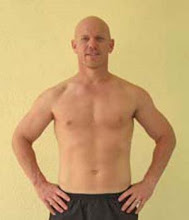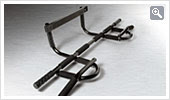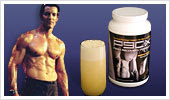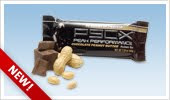By Steve Edwards
In the second part of our talk with RevAbs™ creator Brett Hoebel, we get down to the nitty gritty of how to create that coveted six-pack look that graces the cover of most fitness magazines. You may hear a lot about this in the media, but I think you'll find most of Brett's information will be new, if not downright revolutionary.
For example, even if you know that you can overtrain your abs, you probably aren't sure why or what leads to it. That's because discussing phasic muscles or angles of exercise doesn't make sexy copy. It's easier to show models crunching their ab muscles into oblivion because the concept is simple. But that's about as effective as training for the NBA by just slam-dunking a ball over and over. It's simply one aspect of a complex issue.
But don't let the complexity scare you. We handle that by creating programs so all you have to do is follow along. The goal of today's discussion is simply to enlighten you on the science behind RevAbs. Besides, as Hoebel tells us, "The most important thing to consider on achieving a six-pack (or even flat abs with lines down the side) is what you're willing to do for it."
"People think they can drink their way to a six-pack, or eat all the bread and pasta they want because they're training twice a week by running and doing crunches and using some nonsense ab machine or ab stimulator. They're just fooling themselves, and frankly, they know it."
Science aside, it still all comes down to one thing: desire. "You have to be realistic," says Hoebel. "Those 5-minute ab blast programs you see on TV, and all of those gimmicky machines, don't address the science; they are a cop-out. You have to be willing to change your diet and to train 4 to 5 times a week consistently. You have to do ab training, but you also need to do full-body strength training and cardio, because doing only one or two of them is not enough. Simply put, it all comes down to how bad you want it and what are you willing to endure."
That said, knowing the science behind the six-pack will help guide your training. This is where Hoebel excels. He's trained and studied with some of the biggest names in the business, such as Paul Chek and Charles Poliquin, and has years of trial-and-error experience in developing his reVamp® training method, which is the foundation for RevAbs. This unique background gives him insight you won't find with most trainers. For example, you'll rarely hear an explanation like this for achieving a six-pack:
"You have four abdominal muscles, but the rectus abdominis is divided into the six parts that most people think of as the "six-pack," he begins. "So building this muscle and its six divisions is key. But the other side of the coin is that you've got to burn the fat off the stomach. The best way to do that is to burn more calories by driving the heart rate up. And the key to this is your leg muscles, specifically the quads, hamstrings, and glutes. They are the biggest muscles in the body and can produce the most force and, hence, burn the most calories overall."
So training your legs is pivotal in seeking your six-pack. This is not exactly late-night TV copy, as those muscles aren't seeing a lot of use while reclining on the Ab Lounge®. Most ab programs we see advertised show a lot of midsection movements, mainly crunches. This led to my next line of questioning: Mainly, can you work your abs wrong and is more always better, as those shows would have us believe?
"You can work your abs wrong," he states. "And you can work them too much. In fact, overtraining them is the number one problem there is. People do too much of the same ab exercise/ab angle too often, and they also don't give their abs a chance to rest. They end up overtraining their abs, which usually results in their hip flexors and other muscles doing the majority of the work instead of their abs."
"The abs are like any other muscle group in that they need to rest," he states emphatically. "You can train your abs several days in a row, but you need to make sure and mix up the angles of training on the different days. If your abs are too tired from training, you’re in jeopardy of injuring yourself. They are major muscles in your core region and are involved in stabilizing many parts of the body during other movements. Oftentimes, injuries that happen during other exercises are a direct result of overtrained abs."
Then we get into the crunch mentality, where Hoebel blows the lid off what many of us are taught about ab movements. Traditionally, since most of your ab muscles have a higher percentage of red (or slow twitch) muscle fiber than other muscle groups, the common sentiment is that they are best trained with high volume and low intensity.
"More reps and sets are not always better," he says. "In fact, the rectus abdominis is considered a phasic muscle that should be fatigued in less than 60 seconds. It is strengthened mainly by heavy loads with longer rest periods. Doing hundreds of sit-ups with little to no rest for 10, 15, or 20 minutes would be opposite to this. You should stick to doing exercises that are hard enough, and loaded heavy enough, to fatigue your abs in 60 seconds or less for three to five sets. If you were to do, say, 12 reps for five sets it would be 60 reps total, not hundreds (like some of those programs advertise)."
This leads straight into the next common question about ab work: Should it be done daily?
"No," he states flatly! "The abs are like any other muscle and need to rest. As I said, you can effectively train them several days in a row, but only if you make sure and target different ab angles on the different days. If you are even able to train your abs every day it means that you are not training them hard enough, heavy enough, or correctly on the other days."
Finally, Hoebel sums up by simplifying the scientific process. "If you really want it, and if you’re willing to do the work and pay attention to what actually works, the rest will fall into place."


































